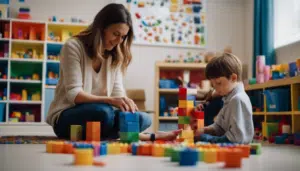Early childhood is a time of rapid growth and learning. Children reach milestones in communication, movement, social interaction, and problem-solving at their own pace. While some variation is normal, understanding the signs of child developmental delays can help address potential challenges early.
What Is Child Developmental Delay?
Child developmental delay occurs when children do not achieve milestones within the expected age range. These delays may involve one or more areas, such as speech and language, motor skills, cognitive abilities, or social-emotional development. Some delays are temporary and resolve with time or targeted support, while others may require long-term attention.
It is worth noting that every child progresses differently. A delay does not necessarily indicate a permanent issue but may signal the need for further observation or intervention. Understanding what typical development looks like allows parents and caregivers to identify possible concerns more confidently.
How Are Delays Identified Early?
Identifying child developmental delays is a pivotal step in making sure children receive the support they need to thrive. By understanding typical milestones and observing a child’s behavior, caregivers and professionals can work together to detect any potential concerns early.
Key steps to identifying developmental delays include:
- Familiarity with developmental milestones: Milestone charts, often used by pediatricians, help track a child’s progress and highlight areas that may need extra attention.
- Observation of daily behaviors: Caregivers should note difficulties in areas like walking, talking, or social interactions and share these observations with professionals.
- Regular health checkups: Pediatricians evaluate development and may provide questionnaires for caregivers about the child’s behaviors to gain deeper insights.
- Hearing and vision assessments: Sensory tests help rule out hearing or vision issues that could impact the child’s development.
Early detection is key, as it allows professionals to recommend tailored resources, therapies, or specialists to address the child’s unique needs and support their growth effectively.
How Do You Track Progress?
Tracking developmental progress can give you a clearer picture of your child’s growth. Many caregivers use milestone charts to see what skills are expected at different ages. These charts, available from pediatricians and trusted organizations, break down development into simple stages so you can check progress easily.
Regular observation helps as well. Take note of how your child communicates, moves, plays, and interacts with others each week. Writing down your observations or keeping a simple journal can help you spot patterns and share accurate information with healthcare professionals. Comparing these notes over time often makes it easier to see if your child is keeping pace or facing challenges in certain areas.
Professional evaluations also play a role in tracking progress. Routine checkups are opportunities for pediatricians to observe your child and answer your questions. If needed, they may suggest more in-depth assessments from specialists. By combining your own observations with regular professional insights, you can support your child’s development in a practical, reassuring way.
Consult a Specialist
Consulting specialists like speech and occupational therapists can help address child developmental delays through tailored interventions. Early support improves communication, motor skills, and social interactions, with strategies easily integrated into daily routines. Proactive guidance empowers families to support each child’s unique growth and potential.
- FREHF – The Revolutionary Future Of Human-Centered Technology!
- Adsy.Pw/Hb3 – Boost Your SEO And Drive More Traffic!
- Fitness Based Vacations By Timeshealthmage.com!
- TimesHealthMag Tips For Improving Sleep Quality – Expert Advice For Better Rest!
- How TimesHealthMage Helps Improve Your Lifestyle Habits!


Leave a Reply